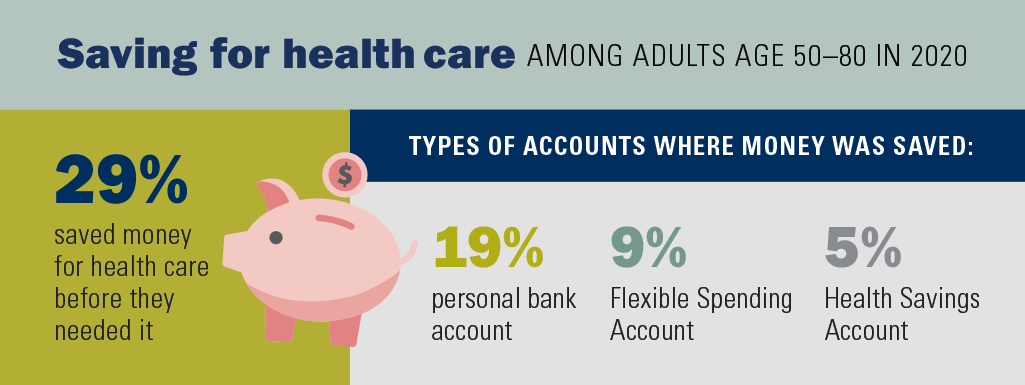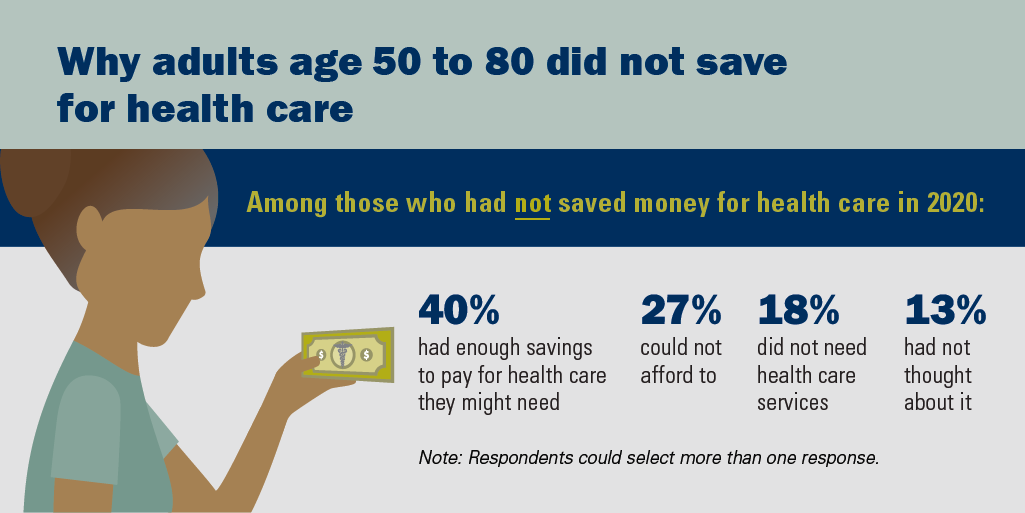
For many older adults, the cost of needed health care services can be a major concern. One way that older adults could be better prepared to handle out-of-pocket health care expenses is by saving money for health care, including in tax-advantaged accounts such as Health Savings Accounts (HSAs), Flexible Spending Accounts (FSAs), and Health Reimbursement Arrangements (HRAs) that can be used to pay for qualified medical expenses. In January 2021, the University of Michigan National Poll on Healthy Aging (NPHA) surveyed a national sample of adults age 50–80 about their concerns about affording needed health care in the future and their saving for health care.
Concerns about being able to pay for needed care
Among adults age 50–80, in the past 12 months (i.e., from January to December 2020), 13% delayed seeking medical care because of worry about the cost, 12% needed medical care but did not get it because they could not afford it, and 15% had problems paying medical, dental, or other health care bills. Nearly one in five (18%) were not at all confident that they would have enough money to pay for health care expenses in the next year.

Health Savings Accounts (HSAs)
An HSA lets individuals set aside money on a pre-tax basis to pay for qualified medical expenses. Individuals or employers can contribute pre-tax dollars to the account, up to an annual limit. Investment gains and funds withdrawn to pay for qualified medical expenses are not taxed. Funds in HSAs are owned by the beneficiary and roll over from year to year. To qualify for an HSA, individuals must have a high-deductible health plan (HDHP), which in 2021 is a private health insurance plan with a minimum deductible of $1,400 for an individual or $2,800 for a family.
Overall, 7% of adults age 50–80 had an HSA. Among the 21% of individuals who were enrolled in an HDHP, fewer than half (45%) had an HSA. Having an HSA was more common among individuals age 50–64 compared to age 65–80 (12% vs. 1%), individuals with at least a bachelor’s degree compared to a high school education or less (13% vs. 3%), individuals with an annual household income of at least $100,000 compared to less than $30,000 (13% vs. 2%), and individuals who reported their physical health as being excellent, very good, or good compared to physical health being fair or poor (8% vs. 3%).
Flexible Spending Accounts (FSAs)
An FSA is offered by some employers to allow employees to set aside their own pre-tax dollars to use throughout the year to reimburse themselves for out-of-pocket health care expenses. Any money that remains in an FSA at the end of the year is forfeited (after a short grace period), unlike HSAs, in which the money rolls over year to year.
Fewer than one in eight adults age 50–80 (12%) reported having an FSA. Having an FSA was more common among individuals age 50–64 compared to age 65–80 (17% vs. 4%), individuals with at least a bachelor’s degree compared to a high school education or less (18% vs. 8%), and individuals with an annual household income of at least $100,000 compared to less than $30,000 (22% vs. 2%).
Health Reimbursement Arrangements (HRAs)
An HRA is an employer-funded group health plan from which employees are reimbursed tax-free for qualified medical expenses up to a fixed dollar amount per year. Unused amounts may be rolled over to be used in subsequent years. Unlike HSAs, funds in HRAs are owned by the employer.
Just 5% of adults age 50–80 reported having an HRA. Having an HRA was more common among individuals with at least a bachelor’s degree compared to a high school education or less (6% vs. 3%), individuals with an annual household income of at least $100,000 compared to less than $30,000 (7% vs. 2%), and individuals who reported their physical health as being excellent, very good, or good compared to physical health being fair or poor (5% vs. 2%).

Saving for health care
In total, fewer than one in three adults age 50–80 (29%) reported that in the past 12 months they had put aside money to pay for health care before they needed it in an HSA (5%), FSA (9%), or personal bank account (19%). Having saved for health care in one of these accounts in the last 12 months was more common among individuals age 50–64 compared to age 65–80 (34% vs. 22%), individuals with at least a bachelor’s degree compared to a high school education or less (38% vs. 22%), and individuals with an annual household income of at least $100,000 compared to less than $30,000 (39% vs. 19%).
Among those who put money aside for health care in the past 12 months, 44% put aside $2,000 or more, 18% put aside $1,000 to $1,999, and 24% put aside less than $1,000.
Among the 71% of adults age 50–80 who had not put aside money to pay for health care in the past 12 months, 40% said they already had enough savings to pay for health care they might need. More than one in four who had not saved (27%) said it was because they could not afford to do so. Other less common reasons were not needing any health care services (18%) and not having thought about it (13%).
Implications
The results of this poll suggest that many adults age 50–80 have concerns about the costs of their health care, but few are saving for health care expenses. Further, while being able to afford needed health care is a major concern for many, not everyone has access to, or can afford to use, tax-advantaged accounts to save and pay for qualified medical expenses.
Tax-advantaged accounts to pay for health care expenses such as HSAs, FSAs, and HRAs have been a major focus of recent health policy reforms. The results of this poll suggest that few older adults have such accounts. Those who have these accounts tend to have higher levels of income and education and be in better health than those who do not. Policymakers, banks, health insurers, and community organizations serving older adults could explore ways to educate and help older adults, particularly those who may face more difficulties affording needed care, benefit from financial incentives to save for future health care expenses.
Fewer than one in three adults age 50–80 reported that in the past 12 months they had put aside money to pay for health care before they needed it in either an HSA, FSA, or personal bank account. Similar to having access to tax-advantaged savings accounts, older adults who had saved in an HSA, FSA, or personal bank account had higher levels of income and education than those who did not.
Although 40% of older adults who had not saved for health care said this was because they already had enough savings to pay for care they might need, 27% said they had not saved because they could not afford to. For older adults who are unable to save for health care expenses, policymakers and insurers should explore other strategies to minimize financial barriers to needed care, such as expanding existing policies that encourage health plans to cover essential services without having to meet a plan deductible.
As health care costs continue to rise, helping more older adults — especially those with greater health needs — save for health care expenses is one important way to ensure they will be able to access and pay for the care they need both now and in the future.
Data Source and Methods
This National Poll on Healthy Aging report presents findings from a nationally representative household survey conducted exclusively by Ipsos Public Affairs, LLC (“Ipsos”) for the University of Michigan’s Institute for Healthcare Policy and Innovation. National Poll on Healthy Aging surveys are conducted by recruiting from Ipsos KnowledgePanel®, the largest national, probability-based panel in the U.S.
This survey module was administered online in January 2021 to a randomly selected, stratified group of older adults age 50–80 (n=2,023). The sample was subsequently weighted to reflect population figures from the U.S. Census Bureau.
The completion rate was 78% among panel members contacted to participate. The margin of error is ±1 to 3 percentage points for questions asked of the full sample and higher among subgroups.
Findings from the National Poll on Healthy Aging do not represent the opinions of the University of Michigan. The University of Michigan reserves all rights over this material.
Read other National Poll on Healthy Aging reports and about the poll's Michigan findings, and learn about the poll methodology.
Citation
Kullgren J, Fendrick AM, Singer D, Kirch M, Solway E, Malani P. Saving for Future Health Care Expenses. University of Michigan National Poll on Healthy Aging. September 2021. Available at: https://dx.doi.org/10.7302/2408
